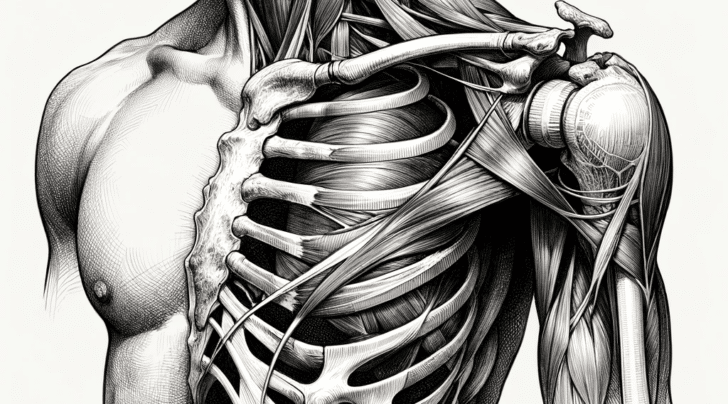
Shoulder pain is a common complaint among adults, potentially with a significant impact on daily activities and quality of life. While various factors contribute to shoulder pain, one of the most notable causes is issues related to the rotator cuff, a group of muscles and tendons stabilizing the shoulder. However, contrary to popular belief, traumatic rotator cuff tears are relatively rare in the adult population. Instead, many rotator cuff tears are age-related and often do not necessitate surgery.
Age-Related Rotator Cuff Tears
As we age, the likelihood of experiencing small tears in the rotator cuff increases. These tears are often a natural part of the aging process and do not always cause pain or require surgical intervention. The body’s remarkable ability to adapt means that many individuals with such tears can continue their daily activities without significant discomfort or functional limitations. This phenomenon underscores the importance of differentiating between incidental findings on imaging studies and clinically significant symptoms requiring treatment.
The Role of Metabolic Health
An often-overlooked aspect of shoulder pain, particularly related to tendon health, is the patient’s metabolic health. Conditions such as Type 2 diabetes, hyperlipidemia, and chronic inflammation have a profound impact on tendon integrity and pain levels. These conditions can lead to a state of chronic inflammation, negatively affecting tendon health and exacerbating pain in individuals with rotator cuff issues.
For example, individuals with poorly managed diabetes may experience glycation, a process where excess sugar molecules attach to collagen fibers in tendons, making them stiffer and more prone to injury. Similarly, hyperlipidemia can lead to fatty deposits within tendons, compromising their strength and elasticity. Chronic inflammation, often seen in these metabolic conditions, further deteriorates tendon health, making them susceptible to tears and causing increased pain.
Age-Appropriate Changes in Shoulder Health
As we age, our bodies undergo numerous changes, and the shoulder is no exception. It’s important to understand that many of these changes are normal and expected parts of aging, not necessarily indicators of serious medical conditions that require invasive interventions. A prime example of such age-appropriate changes is the presence of labral tears in the shoulder.
The labrum is a cuff of cartilage that forms a cup for the ball of the shoulder joint to move within. With age, this cartilage can begin to wear or tear. Surprisingly, labral tears are found in most adults as they age, but they are usually asymptomatic and very rarely require any treatment, let alone surgery.
Understanding MRI Reports
The advent of high-resolution imaging like MRI has made it possible to identify these age-related changes in greater detail. However, this can also lead to unnecessary alarm. When reading an MRI report that mentions terms like ‘labral tear’ or ‘tendon degeneration,’ it’s crucial to interpret these findings in the context of overall shoulder function and symptoms.
Most adults will show some signs of “wear and tear” in their shoulder joints as they age. However, these findings should not automatically lead to conclusions about the need for surgery. In many cases, these changes are asymptomatic and do not interfere with the quality of life or shoulder function.
Avoiding Unnecessary Alarm
The key is not to be unduly alarmed by the terminology used in MRI reports. Many terms that sound concerning are, in fact, descriptions of normal, age-related changes. The decision to opt for surgery should be based on a comprehensive assessment of symptoms, functional limitations, and overall health, not solely on imaging findings.
It’s also essential to have a thorough discussion with your healthcare provider about what these changes mean for your individual case. In many instances, non-surgical management through physical therapy, lifestyle modifications, and pain management techniques can be very effective in managing symptoms associated with these age-related changes in the shoulder.
Understanding and accepting age-appropriate changes in the shoulder can help individuals avoid undue alarm and make informed decisions about their healthcare. While MRI and other imaging techniques are invaluable diagnostic tools, their findings should be interpreted in the context of the patient’s overall health and functionality. Recognizing that many changes are a normal part of aging can help in adopting a more measured approach to shoulder pain management and treatment.
Treatment Approaches for Shoulder Pain
The management of shoulder pain, especially due to rotator cuff issues, typically begins with non-surgical treatments. These may include:
Do you have questions regarding an Orthopedic injury or longevity?
Do you want to talk to an expert who can listen to you for 45-60 minutes and explain the options in detail?
Dr. Howard Luks offers remote guidance sessions to review your X-ray or MRI images and explain your options.
Dr. Luks has also received hundreds of requests for educational sessions on the topics discussed in his book, Longevity Simplified.
- Physical Therapy: Focused on strengthening the muscles around the shoulder, improving flexibility, and reducing strain on the rotator cuff.
- Pain Management: Utilizing anti-inflammatory medications or corticosteroid injections to reduce pain and inflammation.
- Lifestyle Modifications: These include changes in activities that exacerbate shoulder pain and ergonomic adjustments at work or during exercise.
- Addressing Metabolic Health: Managing underlying metabolic conditions through diet, exercise, and medication can significantly improve tendon health and reduce pain.
When Surgery Might Be Considered
While non-surgical treatments are effective for many, surgery may be considered in certain situations:
- Large Rotator Cuff Tears: If imaging reveals a large tear, especially if it is affecting shoulder function, surgery might be necessary to repair the tendon.
- Traumatic Tears: If a rotator cuff tear results from a specific injury, especially in younger, more active individuals, surgical intervention might be the best course of action.
- Persistent Pain: If non-surgical measures fail to alleviate pain and it significantly hampers quality of life, surgery can be considered as a last resort.
In summary, shoulder pain in adults, particularly related to the rotator cuff, is a multifaceted issue. There is often far more nuance involved in determining the best possible treatment plan for you and your unique situation. While age-related tears are common and often manageable without surgery, the impact of metabolic health on tendon integrity and pain levels cannot be overlooked. Effective management of shoulder pain requires a holistic approach that includes physical therapy, lifestyle modifications, managing underlying health conditions, and, in some cases, surgical intervention. Understanding these nuances is crucial for healthcare providers and patients in effectively addressing shoulder pain and improving overall well-being.












